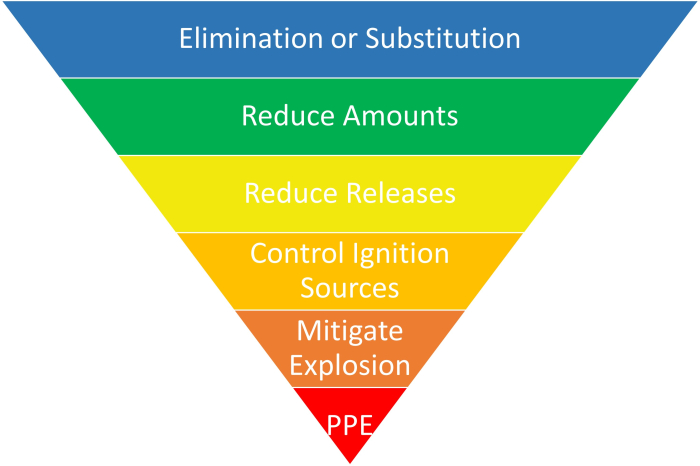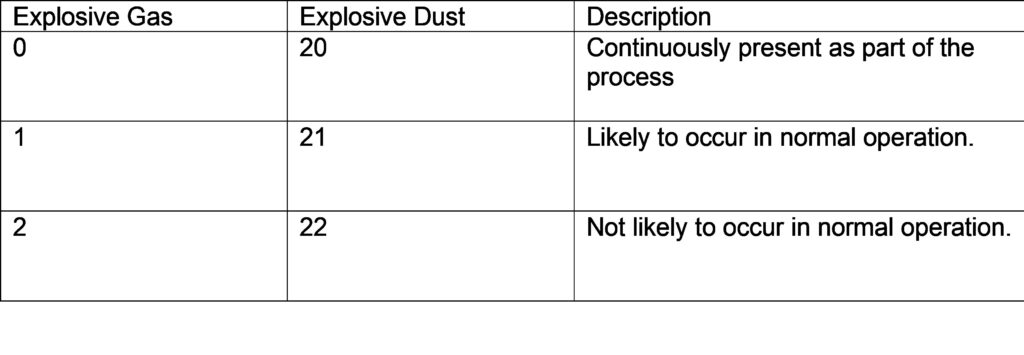In the next part of the ATEX series, Tristan Pulford elaborates on the hierarchy of controls and hazardous area classification. If you missed the first part of this series please click here to catch up.
ATEX, as with all hazards has a hierarchy of control, used for risk reduction. Where possible an organisation should attempt these controls starting with the first, and finishing with the last:
1. Elimination or Substitution – Do you need to use the substance, or can you remove it from site? Can an alternative substance that does not create a potentially explosive atmosphere be used? A typical example of this is hydraulic oil which can be replaced with mineral oils that are not flammable.
2. Reduce Amounts – Can you reduce the amount stored or that is used in the process, which will reduce the potential consequences of an incident?
Typically, these first two steps are easy to answer, because the substance is required as part of the process. This is rarely however documented, and it is important to be able to prove that no alternative or reduction is possible.
3. Reduce Releases – Design the system so that any release of mist, gas, vapour, or dust are minimised. This can be in volume, duration or even the amount of release sources. If for example, you only have one release source it is easier to control than the entire room having a release source
4. Control Ignition Sources – If a release and hence potentially explosive atmosphere is possible, then you need to control the ignition sources within that area. This applies to normal operation, equipment failure and maintenance work. This is where lighting will come in later. Another method of controlling ignition sources that fall partly in control and partly in mitigation is spark detection and suppression. This is a system that will detect a spark and douse it rapidly (typically with CO2, N2) before ignition of the explosive atmosphere can occur.
5. Mitigate Explosion – If there was to be an ignition it is also possible through engineering means to mitigate an explosion, through explosion vents and explosion suppression. These need to be properly specified to be able to handle the energy and speed of any potential explosion.
6. PPE and Information – Finally at the bottom is the provision of PPE information and training for people working within or in the vicinity of the area. This is key for anyone carrying out maintenance or installing ATEX rated equipment.
Hazardous Area Classification
Hazardous Area Classification is also called Zoning when it comes to ATEX, and it is the process of defining a likelihood of an explosive atmosphere being present. There are various standards available that provide guidance on this, but the zones are split into 3 categories.
Typically, Zone 0/20 are easy to identify, but where possible equipment in those areas should be avoided. Typically, this is within pipework and within vessels, hoppers/ silos, areas where equipment is limited.
For the remaining zones, the word “likely” must be interpreted. In the oil and gas world, the IGEM and Energy Institute standards provide guidance on when these zones occur, such as on a creep relief or condensate drain.
For dust depending on the application, there is guidance but in our experience, there are some common areas that are frequently missed. That is items such as flexible connections, which are a common failure point as over time they can crack and provide small leakage points, and through breathers when the filter fails, etc.
One of the common items where zoning is missed is a manually loaded hopper with Local Exhaust Ventilation (LEV). In normal operation the LEV would remove any potentially explosive atmosphere, however, if the hopper can be loaded when the LEV is not running (or is broken) then a Zone 22 would still be present. A similar principle is required with mechanical ventilation and any item which could foreseeably fail.
It is important to mention that for gases there is also a Zone 2 Negligible Extent (NE), which is a situation where, due to the ventilation and leakage rates, and potentially explosive atmosphere of no larger than 0.5m3 can be created. In this case, ATEX equipment is not required in that area, however other controls for maintenance such as hot works are still required.
In the next instalment in this series, we consider control ignition sources and lighting.
For any more information on ATEX or anything else you’ve read here please contact [email protected].
To subscribe to the Finch Consulting newsletter for updates please click here.






